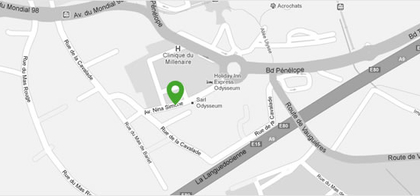Gastric bypass
The operation will last for 1½ to 2½ hours (if no complications)
Average duration of hospitalisation 4 to 6 days (if no complications)

- the commonest form of surgery in the USA
- technically the most complex form of surgery
- requires 6 to 7 laparoscopic openings
Information updated on 29/07/2019
The gastric bypass technique has been in use for more than forty years. It consists of reducing the size of the stomach to decrease food intake and by-passing part of the stomach and intestine so that less of the food is assimilated.
Advantages
- expected weight loss of between 70% and 100% of excess weight, i.e. weight loss of approximately 30kg to 45 kg for a person of average height (1.70 m) with a BMI of 40 kg/m²
- a quicker feeling of fullness during meals and a hormonal effect that reduces the feeling of hunger
- a technique used for more than forty years, with well-known results, even in the long term
- no removal of any organs (unlike the sleeve)
- no insertion of foreign bodies (unlike the gastric band)
- no gastric reflux
Disadvantages of the surgery
- procedural mortality rate of 0.5% (source: HAS), caused mainly by cardiac or pulmonary problems.
- possible complications: ulcer, gastric leak or shrinkage, haemorrhage, intestinal occlusion, dumping syndrome
- vitamin tablets required for the rest of your life (2 tablets / day) to avoid the risk of vitamin deficiency
- examination of the bypassed portion of the stomach by fibroscopy at a later date is impossible
Secondary menu
Home
Millénaire Obésité Montpellier - Obesity treatment centre
Obesity treatment
centre
Tel. : +33 4 67 42 19 70
Fax : +33 4 67 42 42 66
This website is designed to provide information but it cannot replace a consultation.
Schedule menu
- Glossary of terms
- Legal information
- Sitemap
-
© Millénaire Obésité Montpellier - Obesity treatment centre - Design Metycea

